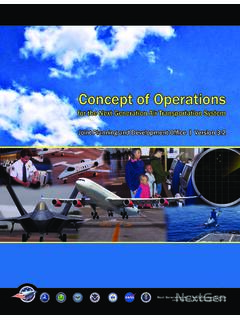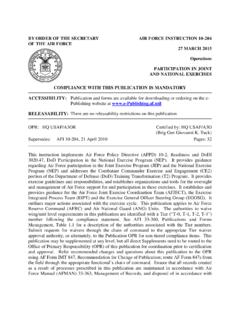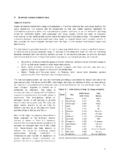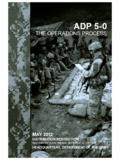Transcription of Marine Corps Operations - barrackslife.com
1 MCDP 1-0. Marine Corps Operations Marine Corps PCN 142 000014 00. DEPARTMENT OF THE NAVY. Headquarters United States Marine Corps Washington, DC 20308-1775. 27 September 2001. FOREWORD. Marine Corps Doctrinal Publication (MCDP) 1-0 is the first Marine Corps Operations doctrinal publication written for the Marine component and the Marine air-ground task force (MAGTF). It represents how our warfighting philosophy is codified in operational terms. MCDP 1-0 is intentionally written broadly to capture the employment of Marine components and the MAGTF. across the range of military Operations . The supporting tactics, techniques, and procedures (TTP) are contained in our warfighting and reference publications. This doctrinal publication is the transition the bridge between the Marine Corps ' warfighting philosophy of maneuver warfare to the TTP used by marines .
2 MCDP 1-0 is written for the Marine component and the MAGTF and is the precursor to future MAGTF-oriented warfighting doctrine. It addresses how the Marine Corps conducts Operations to support the national military strategy across the broad range of naval, joint, and multinational Operations . MCDP 1-0 explores the contribution to the national defense provided by the unique structure of Marine Corps organizations the Marine component and the MAGTF. It reflects the notion that "words matter", providing definitions of key operational terms to ensure that marines speak a common operational language. It describes the role of the Marine component in providing, sustaining, and deploying Marine Corps forces at the operational level of war and how the MAGTF conducts expeditionary Operations at the operational and tactical levels.
3 MCDP 1-0 focuses on how Marine Corps forces conduct Operations today and the direction the Marine Corps capstone concept expeditionary maneuver warfare and the supporting concepts of operational maneuver from the sea and ship-to- objective maneuver will take Marine Corps Operations in the near future. MCDP 1-0 concentrates on the operating forces of the Marine Corps Marine Corps forces as a Service component under joint force command, and the MAGTF. It acknowledges that Marine Corps Operations are now and will continue to be joint and likely multinational. It describes how Marine Corps forces support the joint or multinational force commander and what capabilities the marines bring to a joint or multinational force. It illustrates how the Marine Corps ' task-organized combined arms forces, flexibility, and rapid deployment capabilities apply to the widening spectrum of employment of today's military forces.
4 This publication provides the fundamentals of how MAGTFs conduct tactical Operations and concisely addresses the types of Operations MAGTFs will conduct to accomplish these missions. Marine Corps commanders and leaders at all levels should read and study this publication. Additionally, joint force commanders and their staffs can use this publication to better understand the capabilities of Marine Corps forces assigned to the joint force. /s/. J. L. JONES. General, United States Marine Corps Commandant of the Marine Corps DISTRIBUTION: 142 000014 00. 2001 United States Government as represented by the Secretary of the Navy. All rights reserved. Throughout this publication, masculine nouns and pronouns are used for the sake of simplicity. Except where otherwise noted, these nouns and pronouns apply to either gender.
5 MCDP 1-0, Marine Corps Operations . TABLE OF CONTENTS. Chapter 1 The Marine Corps in National Defense Historical Role .. 1-3. The Character of Modern Conflict.. 1-6. Operational Environment.. 1-7. Threat Dimension .. 1-7. Political Dimension .. 1-9. Levels of War .. 1-9. Range of Military Operations .. 1-10. The National Security Structure.. 1-10. National Command Authorities .. 1-10. The Chairman of the Joint Chiefs of Staff .. 1-10. The Joint Chiefs of Staff .. 1-11. Unified Action .. 1-11. Joint Operations .. 1-11. Multinational Operations , Alliances, and Coalitions .. 1-12. Roles and Functions .. 1-13. Title 10, United States Code, Armed Forces.. 1-13. Goldwater-Nichols Department of Defense Reorganization Act of 1986 .. 1-14. Department of Defense Directive , Functions of the Department of Defense and its Major Components.
6 1-15. Marine Corps Manual .. 1-16. Commandant of the Marine Corps .. 1-16. Organization and Structure .. 1-17. Headquarters, Marine Corps .. 1-17. Operating Forces .. 1-18. Supporting Establishment .. 1-22. Marine Corps Forces Reserve .. 1-22. Marine Corps Ethos .. 1-23. iv MCDP 1-0. Chapter 2 Marine Corps Expeditionary Operations Marine Corps Core Competencies .. 2-2. Warfighting Culture and Dynamic Decision-making .. 2-2. Expeditionary Forward Operations .. 2-2. Sustainable and Interoperable Littoral Power Projection.. 2-3. Combined Arms Integration .. 2-3. Forcible Entry from the Sea .. 2-3. Expeditionary Operations .. 2-4. Force Projection .. 2-5. Amphibious Operations .. 2-6. Amphibious Operation Command Relationships.. 2-6. Forcible Entry through an Amphibious Assault.. 2-8. Sequence.. 2-9. Maritime Pre-positioning Force.
7 2-11. Sustained Operations Ashore .. 2-12. Enabling Force .. 2-12. Decisive Force .. 2-12. Exploitation Force .. 2-13. Sustaining Force .. 2-13. Emerging Concepts and Technologies .. 2-13. Expeditionary Maneuver Warfare.. 2-14. Operational Maneuver from the Sea .. 2-15. Ship-to-Objective Maneuver .. 2-16. Maritime Pre-positioning Force Future .. 2-17. Expeditionary Bases and Sites .. 2-18. Chapter 3 Marine Corps Forces Marine Corps Component .. 3-1. Role and Responsibilities to the Commandant.. 3-3. Role and Responsibilities to a Combatant Commander .. 3-3. Role and Responsibilities to the Joint Force Commander .. 3-4. Joint Operations Conducted Through Service Component Commanders.. 3-5. Joint Operations Conducted Through Functional Component Commanders .. 3-5. The Marine Corps Component Commander as a Functional Component Commander.
8 3-7. Marine Corps Operations v Role and Responsibilities to the MAGTF Commander.. 3-9. Component Command Relationships and Staff Organization.. 3-10. The Marine Air-Ground Task Force .. 3-10. Capabilities .. 3-11. Elements .. 3-12. Supporting Establishment .. 3-15. Types .. 3-16. Marine Logistics Command .. 3-20. Chapter 4 Employment of Marine Corps Forces at the Operational Level Battlespace Organization .. 4-3. Area of Operations .. 4-4. Area of Influence .. 4-6. Area of Interest .. 4-7. Boundaries, Maneuver Control Measures, and Fire Support Coordinating Measures .. 4-7. Deployment .. 4-10. Force Deployment Planning and Execution .. 4-10. Predeployment Activities .. 4-14. Movement to and Activities at the Port of Embarkation .. 4-15. Movement to the Port of Debarkation .. 4-16. Reception, Staging, Onward Movement, and Integration.
9 4-16. Deployment Forces .. 4-16. Employment .. 4-18. Planning Approach .. 4-19. Arranging Operations .. 4-20. Combat Power .. 4-21. Warfighting Functions.. 4-21. Information Operations .. 4-22. Redeployment.. 4-24. Expeditionary Operations in Support of Future Campaigns .. 4-24. Chapter 5 Logistics in Marine Corps Operations Levels .. 5-3. Strategic Logistics .. 5-4. Operational Logistics.. 5-4. Tactical Logistics.. 5-5. vi MCDP 1-0. Functions .. 5-5. Supply.. 5-6. Maintenance .. 5-6. Transportation .. 5-7. General Engineering.. 5-7. Health Services.. 5-7. Services .. 5-7. Joint and Multinational Operations .. 5-8. Strategic Logistics Support .. 5-10. Strategic Mobility.. 5-10. United States Transportation Command .. 5-11. Department of Transportation .. 5-12. Defense Logistics Agency .. 5-12. Operational Logistics Support.
10 5-12. Marine Corps Component .. 5-12. Marine Logistics Command .. 5-13. Reconstitution.. 5-14. Command and Control .. 5-15. Logistics Support to MAGTF Operations .. 5-16. Marine Expeditionary Force.. 5-17. Marine Expeditionary Brigade .. 5-18. Marine Expeditionary Unit (Special Operations Capable).. 5-18. Special Purpose MAGTF .. 5-18. Air Contingency Force .. 5-19. Maritime Pre-positioning Forces .. 5-19. Aviation Logistics Support Ship .. 5-19. Norway Geopre-positioning Program .. 5-19. War Reserve Materiel Support .. 5-20. Tactical Level Command and Control .. 5-20. Supporting Establishment .. 5-20. Marine Corps Combat Development Command .. 5-21. Marine Corps Materiel Command .. 5-21. Marine Corps Bases, Stations, and Reserve Support Centers .. 5-22. Department of the Navy Agencies .. 5-22. Future Sustainment Operations .







